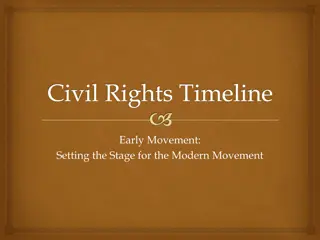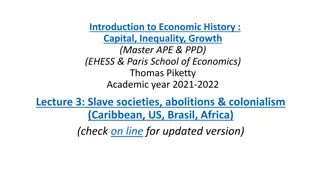The Impact of Early Slave Trading in Africa and the New World
Portuguese were the first to establish slave trading patterns in Africa, initially raiding for slaves but later engaging in trade with African rulers. Other European nations followed suit, leading to the emergence of large states like Asante and Dahomey involved in the slave trade. The demand for labor in the New World, particularly in Brazil and the Caribbean for sugar plantations and mines, further fueled the trade. By 1450-1850, millions of Africans were sent across the Atlantic, with high mortality rates and significant trade statistics.
Download Presentation

Please find below an Image/Link to download the presentation.
The content on the website is provided AS IS for your information and personal use only. It may not be sold, licensed, or shared on other websites without obtaining consent from the author.If you encounter any issues during the download, it is possible that the publisher has removed the file from their server.
You are allowed to download the files provided on this website for personal or commercial use, subject to the condition that they are used lawfully. All files are the property of their respective owners.
The content on the website is provided AS IS for your information and personal use only. It may not be sold, licensed, or shared on other websites without obtaining consent from the author.
E N D
Presentation Transcript
Early Slave Trading Portuguese first to establish patterns of contact & trade with Africa (forts and trading posts with resident merchants) Originally raided the coast for slaves, but eventually began trading with African rulers Other European nations followed & began setting up trading stations for slaves
Early Slave Trading Slavery already existed on the continent of Africa which allowed Europeans to mobilize slave commerce by quickly tapping into existing routes African rulers enslaved their neighbors, so expanding, centralized states were often major suppliers of slaves to the Europeans.
Early Slave Trading During the age of the slave trade, several large states developed and traded goods for slaves to the European merchants Asante located along the Gold Coast; several small clans were united under the supreme civil & religious ruler; their access to firearms allowed for centralization and expansion Access to gold-producing zones & constant supply of prisoners to be sold led them to be the dominant state of the Gold coast until the 1820s Dahomey 70 miles from the coast; an autocratic, sometimes brutal regime; its armies raided for more captives
As the colonies emerged in the New World, the need for labor grew and the slave trade expanded Brazil & the Caribbean became the two areas with the greatest demand for slaves because of the sugar plantations and the mines, which were both labor intensive In these areas, almost 80-90% of the population were from Africa.
Slave Trade Stats 1450-1850 12 million Africans sent across Atlantic 10-11 survive 18th century Height 80 percent of total trade Muslim areas Trans-Saharan, Red Sea, East Africa 3 million slaves traded Saharan trade Mostly women (harems & domestics) Atlantic trade Primarily young men for hard labor
White Settlers & Africans in Southern Africa Area of Africa least affected by the slave trade Bantu into southern Africa by 1500 Left arid areas to Khoikhoi(hunting/sheepherding), San (bushman) Agriculture, pastoralism Iron, copper Chiefdoms common Capetown (Cape of Good Hope) Dutch colony, 1652 Estates worked by slaves Wars with San, Khoikhoi By 1760s, encounter Bantu 1795, Britain occupies colony 1815, possession After 1834, Afrikaners push beyond boundaries
Nguni people 1818, Shaka creates Zulu chiefdom 1828, assassinated Beginning of mfecane wars of crushing and wandering Groups spun off to the north & south, raiding the Portuguese, clashing with Europeans, & fighting with neighboring chiefdoms.
The African Diaspora Slave trade drew African societies into the world economy Disrupted families Millions killed The Middle Passage slave voyage to the Americas; particularly traumatic, dangerous However, Africans retained their language, beliefs, artistic traditions, and memories
Saltwater slaves African-born Creole slaves their American-born descendants, some of whom were mulattos In the Americas, whites were at the top, with slaves at the bottom, and free people of color in between Unlike Africa, race and color now played a role in slavery Eventually, North America became less dependent on slaves from Africa, as the slave population was reproducing itself.
Once in the Americas, the beliefs and customs of Africans merged into a whole new Afro-American culture Africans blended customs with other African peoples, as well as incorporating the existing European/American culture End of the Slave Trade several factors have been attributed to the end such as: The Enlightenment The Age of Revolution Christian revivalism The Industrial revolution


![Guardians of Collection Enhancing Your Trading Card Experience with the Explorer Sleeve Bundle [4-pack]](/thumb/3698/guardians-of-collection-enhancing-your-trading-card-experience-with-the-explorer-sleeve-bundle-4-pack.jpg)




















